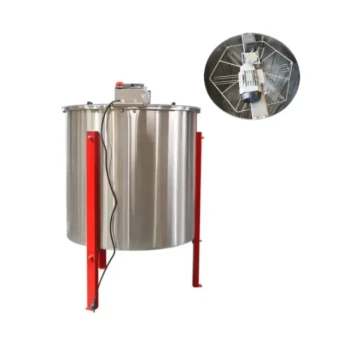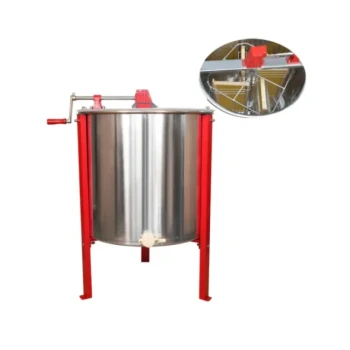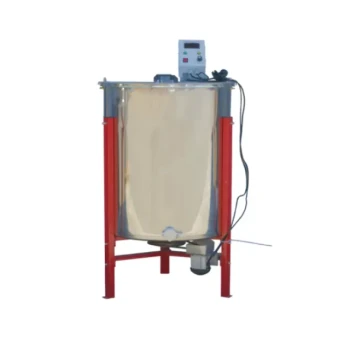The fundamental difference lies in how the honey frames are positioned inside the extractor, which directly impacts the speed and labor involved in the process. A tangential extractor holds frames with one flat side of the honeycomb facing outward, extracting honey from that side only. In contrast, a radial extractor positions frames like spokes on a wheel, allowing centrifugal force to pull honey from both sides of the comb simultaneously.
The choice between a tangential and radial honey extractor is a decision about operational scale. Tangential extractors are simpler and often more affordable, suited for hobbyists, while radial extractors are built for speed and efficiency, making them the standard for larger-scale beekeepers.
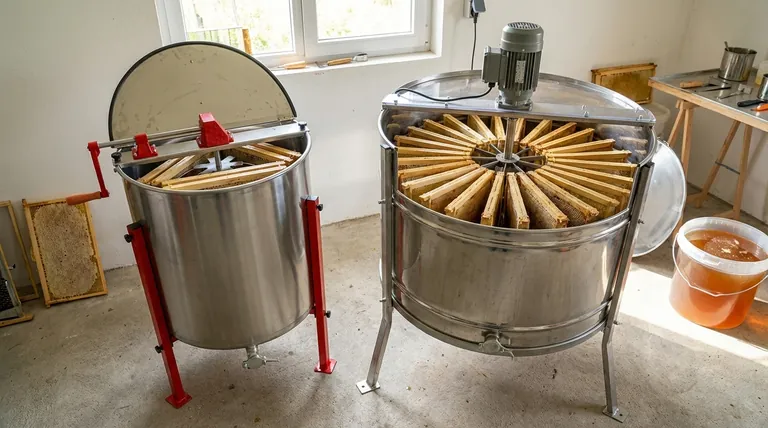
The Core Mechanic: Frame Orientation
The design of an extractor dictates how it uses centrifugal force. The orientation of the frame is the single most important factor that separates these two types.
How a Tangential Extractor Works
A tangential extractor holds the frames so the flat, broad side of the honeycomb faces the outer wall of the drum, much like a passenger pressed against the wall of a spinning ride.
When the extractor spins, honey is pulled from this outward-facing side. To extract honey from the other side, you must stop the machine, manually flip each frame, and then spin it again.
How a Radial Extractor Works
A radial extractor positions frames vertically with the top bar facing the outer wall, similar to the spokes of a bicycle wheel.
As it spins, honey is thrown from the cells on both sides of the frame at the same time. The slight upward angle of the honeycomb cells naturally facilitates this dual-sided extraction.
The Impact on Speed and Labor
The radial design is inherently faster and requires significantly less labor. There is no need to stop and flip frames midway through the process.
This makes radial extractors far more efficient, especially when processing a large number of frames from multiple hives.
A Second Critical Factor: Power Source
While the frame orientation is the primary difference, the power source is an equally important consideration that often correlates with the extractor type.
Manual (Hand-Crank) Extractors
Manual extractors use a hand crank to spin the basket. They are simple, require no electricity, and are generally less expensive.
This power method is most common in smaller tangential extractors, making them a popular and cost-effective choice for beginners and hobbyists with only a few hives.
Motorized (Electric) Extractors
Electric extractors use a motor to provide consistent and controllable spinning power. This automates the process, reduces physical effort, and often results in a higher honey yield.
While some tangential models are motorized, almost all radial extractors are electric, reinforcing their role as the tool for larger, more serious beekeeping operations.
Understanding the Trade-offs
Choosing an extractor involves balancing cost against efficiency. There is no single "best" type; there is only the best type for your specific needs.
Efficiency vs. Cost
Radial extractors are the clear winner for efficiency, but they come with a higher price tag due to their more complex design and the inclusion of a motor.
Tangential extractors are far more budget-friendly, but the time and labor cost is higher due to the manual flipping of frames.
Scale of Operation
For a beekeeper with one to four hives, a manual tangential extractor is often perfectly adequate. The time spent flipping frames is minimal in the context of a small harvest.
For a beekeeper with five or more hives, a motorized radial extractor quickly becomes a worthwhile investment. The time saved can be measured in hours, not minutes.
Potential for Comb Damage
With tangential extractors, spinning the first side too quickly can cause the delicate comb to break, as the full weight of the honey on the inner side pushes against it. This requires a more careful, two-speed approach.
Radial extractors exert a more even force across the frame, significantly reducing the risk of "blowing out" the comb, even at higher speeds.
Making the Right Choice for Your Apiary
Your decision should be guided by the current size and future goals of your beekeeping operation.
- If your primary focus is a small-scale hobby (1-4 hives): A manual tangential extractor offers the best balance of affordability and functionality for your needs.
- If your primary focus is a growing operation or serious sideline (5+ hives): A motorized radial extractor is a major quality-of-life upgrade that will save you significant time and labor.
- If your primary focus is commercial production: A large, motorized radial extractor is the professional standard and the only practical tool for efficient processing.
Ultimately, choosing the right extractor is about matching the tool to the scale of your passion and work.
Summary Table:
| Feature | Tangential Extractor | Radial Extractor |
|---|---|---|
| Frame Orientation | Frames flat against the drum wall | Frames like spokes on a wheel |
| Extraction Process | One side at a time; frames must be flipped | Both sides of the frame simultaneously |
| Best For | Hobbyists (1-4 hives) | Larger operations (5+ hives) |
| Typical Power Source | Manual (hand-crank) | Motorized (electric) |
| Labor Intensity | Higher (requires manual flipping) | Lower (fully automated spinning) |
| Relative Cost | Lower initial investment | Higher initial investment |
Ready to Scale Your Honey Harvesting?
Whether you're a commercial apiary or a beekeeping equipment distributor, choosing the right extractor is critical for efficiency and profitability. HONESTBEE supplies the durable, high-performance beekeeping equipment you need to succeed.
We offer a range of tangential and radial honey extractors tailored for wholesale-focused operations. Let our experts help you select the perfect equipment to maximize your honey yield and minimize labor.
Contact HONESTBEE today for wholesale pricing and expert advice tailored to your commercial needs!
Visual Guide
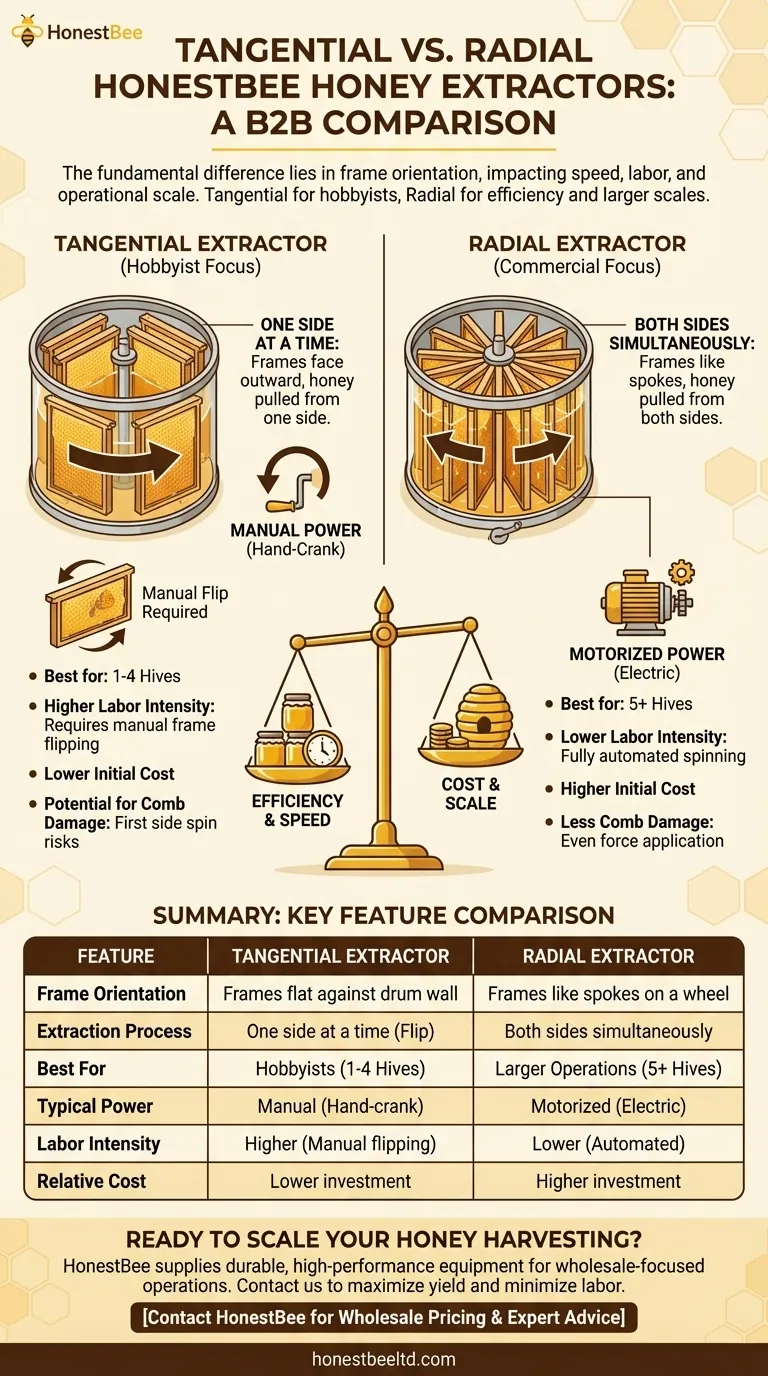
Related Products
- Stainless Steel Manual 8 Frame Radial Honey Extractor Machine for Beehives
- HONESTBEE 72 Frame Industrial Electric Honey Extractor for Beekeeping
- 8-Frame Electric Self-Reversing Honey Extractor Spinner for Commercial Honey Extraction Equipment
- 2 Frame Stainless Steel Manual Honey Spinner Extractor for Beekeeping
- HONESTBEE 6 Frame Self Reversing Electric Honey Extractor for Beekeeping
People Also Ask
- What is the difference between a radial and tangential honey extractor? Boost Your Harvest Efficiency
- What is a tangential extractor and how does it work? A Complete Guide for Hobbyist Beekeepers
- What are radial honey extractors and what are their features? Maximize Your Honey Harvest Efficiency
- What are the advantages of tangential honey extractors? Gentle, Affordable Honey Extraction for Your Apiary
- How does centrifugation work in honey extraction? The Sustainable Method for Modern Beekeepers




